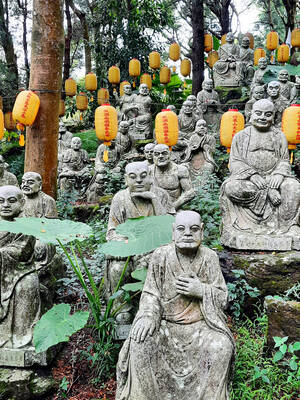What appears to be a sumo wrestler runs around the stage in a latex pink mask and a huge pink diaper. Three girls of varying sizes in elaborate costumes wail away on horns. The guitarist’s cape billows in the smoke, the bass player’s glitter reflects the stage lights, and the fishnet body stocking- and thong-clad drummer pounds out an irresistible beat. It’s like a little piece of Japanese weirdness has just dropped fully formed out of the sky and onto the stage. Meet Mimie Chan.
Members of the seven-piece ska band were a Spring Scream staple from 2000 to 2008 but their loyal following of Screamers have had to make do without them for the last couple of years as the whole band was on hiatus. Now they’ve reunited, and though they were unable to make it in time for Spring Scream this year, they arrive this weekend to take part in Urban Nomad’s festivities.
Their “mind-blowing” shows were an inspiration to other musicians, said Spring Scream founder Wade Davis, who will come up to Taipei from Taichung to catch them. “They take full advantage of the stage,” he said. Their costumes — from bumblebees to geishas to wrestler masks and superhero outfits — and range of instruments lead to a high-energy performance and “fun, danceable music,” said Davis.
Their music is a cross between noise-punk, classic punk, ska and pure Mimie Chanism. “Our songs have no meaning I think,” said guitarist Yutaka Ozawa. “We have two albums and we just made lyrics that same day at the studio,” he continued. “We just put some words together. One song goes ‘What is this crunchy thing?’ and the answer will be ‘Just wait one more day.’”
Is there any meaning behind their outfits? “We just want to wear some costumes [because] it makes the show funny,” said Ozawa. His getup tomorrow will be “some kind of dress and a fan so the wind makes it look like flying,” he said. What about the band name? “Means nothing,” he said. “Could be a cat or dog’s name ... ‘Chan’ is for ‘little girl.’”
Does any of it mean anything? “We once tried to make a song about an alien creature named Mimie Chan. Our first concept was ‘Mimie Chan went shopping,’” he said, laughing.
Also playing at Urban Nomad’s annual party (in conjunction with the film festival) is eight-piece band Skaraoke, which includes a full horn section, and Touming Magazine (透明雜誌). The latter was started by lead singer/guitarist Chimpanzee (洪申豪) and guitarist Tang Shi-jie (唐世杰) after their emo band Fall of this Corner (一隅之秋) broke up in 2005. With influences like The Pixies, Sonic Youth and Fugazi, they use jazzy drums and heavy guitar effects to create a high-energy sound.
Finishing up the night will be DJ Floaty with his eclectic, eccentric, diverse range of music that rocks Underworld (地下社會) and Fucking Place (操場) crowds on a regular basis.
It’s a night for musicians and music lovers, and the film being screened at the party — Favela on Blast — fits the bill. The documentary, set in the favelas, or slums, of Rio de Janeiro, follows Wesley Pentz aka DJ Diplo as he explores the music and dance phenomena Baile Funk (built around remixes of 1980s American dance beats and Brazilian samba music) as it sweeps through violent gang turf.
Documentaries take center stage at the festival this year with the film everyone has been waiting to see — The Cove — premiering tonight at 7:30pm at the Armed Forces Cultural Center at 69 Zhonghua Rd, Sec 1, Xindian, Taipei County (台北縣新店市中華路一段69號). There’s an after-party later with Mimie Chan’s “sumo wrestler” Yusuke Shimizu as DJ Pencil on the decks. See Urban Nomad’s Web site (in the box) for details.
Tomorrow’s party at Huashan 1914 Creative Park's (華山1914), Warehouse E3 (烏梅酒廠) starts at 8pm with the documentary, followed by bands from 10pm. Expect to see many of the main players in Taiwan’s expat music scene turn up to catch old friends Mimie Chan even if they, like Davis, will have had to travel from out of town for the event.
“We now feel happy with the fact we didn’t sell our musical instruments for money,” said diaper-wearing Mimie Chan member Shimizu, who contributes “excitement and keyboards” to the band, when asked about the reunion.

When Taiwan was battered by storms this summer, the only crumb of comfort I could take was knowing that some advice I’d drafted several weeks earlier had been correct. Regarding the Southern Cross-Island Highway (南橫公路), a spectacular high-elevation route connecting Taiwan’s southwest with the country’s southeast, I’d written: “The precarious existence of this road cannot be overstated; those hoping to drive or ride all the way across should have a backup plan.” As this article was going to press, the middle section of the highway, between Meishankou (梅山口) in Kaohsiung and Siangyang (向陽) in Taitung County, was still closed to outsiders

President William Lai (賴清德) has championed Taiwan as an “AI Island” — an artificial intelligence (AI) hub powering the global tech economy. But without major shifts in talent, funding and strategic direction, this vision risks becoming a static fortress: indispensable, yet immobile and vulnerable. It’s time to reframe Taiwan’s ambition. Time to move from a resource-rich AI island to an AI Armada. Why change metaphors? Because choosing the right metaphor shapes both understanding and strategy. The “AI Island” frames our national ambition as a static fortress that, while valuable, is still vulnerable and reactive. Shifting our metaphor to an “AI Armada”

US President Donald Trump may have hoped for an impromptu talk with his old friend Kim Jong-un during a recent trip to Asia, but analysts say the increasingly emboldened North Korean despot had few good reasons to join the photo-op. Trump sent repeated overtures to Kim during his barnstorming tour of Asia, saying he was “100 percent” open to a meeting and even bucking decades of US policy by conceding that North Korea was “sort of a nuclear power.” But Pyongyang kept mum on the invitation, instead firing off missiles and sending its foreign minister to Russia and Belarus, with whom it

The older you get, and the more obsessed with your health, the more it feels as if life comes down to numbers: how many more years you can expect; your lean body mass; your percentage of visceral fat; how dense your bones are; how many kilos you can squat; how long you can deadhang; how often you still do it; your levels of LDL and HDL cholesterol; your resting heart rate; your overnight blood oxygen level; how quickly you can run; how many steps you do in a day; how many hours you sleep; how fast you are shrinking; how